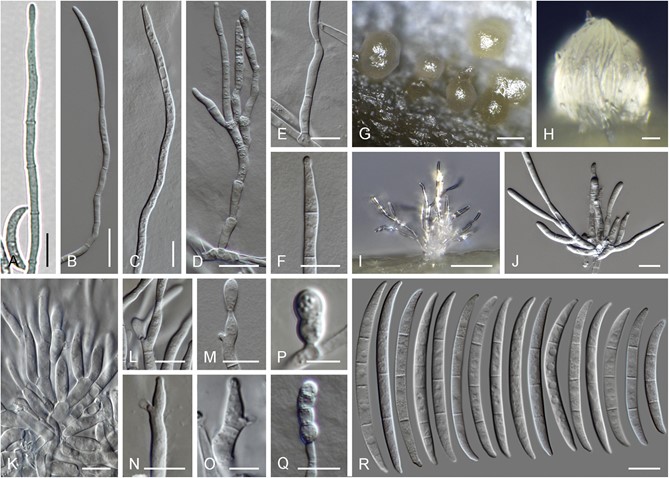Nothofusarium devonianum L. Lombard, Crous & Sand.-Den., sp. nov.
MycoBank number: MB 838675; Index Fungorum number: IF 838675; Facesoffungi number: FoF 10987; Fig. 41.
Etymology: The epithet refers to Devon, the English county where the type specimen was collected.
Typus: UK, England, Devon, Totnes, Berry Pomeroy, Loventor Manor, on dead cladodes of Ruscus aculeatus, 17 Jul. 1983, B.C. Sutton & A.V. Sutton (holotype CBS H-24670, culture ex- type CBS 147304 = IMI 279297 = NRRL 22134).
Conidiophores borne on substrate mycelium, prostrate or erect and quickly collapsing to the agar surface, 70– 240 μm tall, un- branched or less commonly irregularly laterally branched, bearing terminal single phialides; aerial conidiogenous cells monophialidic, subulate to cylindrical, smooth- and thin-walled, 9– 34 μm long, 2– 5 μm at the widest part, or reduced to short phialidic pegs, 3– 6 × 2– 3.5 μm, formed laterally on aerial hyphae, apical collarettes short or lacking, periclinal thickening absent. Aerial macroconidia borne on tips of conidiogenous cells on aerial conidiophores, almost straight or slightly curved, falcate, 1– 5(– 6)-septate, predominantly 3-septate, hyaline, smooth- and thick-walled, with a blunt apical cell and obtuse, sometimes papillate to poorly-developed, foot-shaped basal cell, 1-septate conidia: (15.5 –)19 – 28(– 32) × 2.5 – 4 μm (av. 23.5 × 4.3 μm); 2-septate conidia: (25.5 –)27– 31 × 2.5 – 4 μm (av. 28.8 × 3.2 μm); 3-septate conidia: (13–) 41– 57(– 63.5) × 3– 4(– 4.5) μm (av. 49 × 3.6 μm); 4-septate conidia: (48.5 –)50– 60(– 61.5) × 3– 4.5 μm (av. 55.1 × 3.8 μm); 5-septate conidia: (47–)50 – 64(– 71) × 3.5 – 4.5 μm (av. 56.9 × 3.9 μm); 6-septate conidia: (54 –)55– 71.5 × 3.5 – 4 μm (av. 62.3 × 3.8 μm); overall: (13–)35.5 – 59(– 71.5) × 2.5 – 4.5 μm (av. 47.2 × 3.6 μm). Sporodochia pale luteous to pale citrine coloured, small, formed abundantly on the agar surface and less regularly on the surface of carnation leaves; sporodochial co- nidiophores irregularly verticillately branched bearing solitary lateral and terminal phialides or apical groups of 2– 3 phialides; sporodochial conidiogenous cells mono- and polyphialidic, doliiform, subulate to subcylindrical, 3 – 25.5 × 2.5 – 5 μm, smooth and thin-walled, commonly proliferating sympodially, collarettes and periclinal thickening absent or inconspicuous. Sporodochial conidia undifferentiable from aerial conidia. Chlamydospores subglobose to ellipsoidal, solitary or most commonly in chains. Sexual morph unknown.
Culture characteristics: Colonies on PDA reaching 23– 27 mm diam at 25 °C after 7 d. Surface straw-coloured, pale luteous to pale ochreous, flat, dusty to velvety; reverse white to pale luteous without diffusible pigments. On OA, grey-white to pale luteous, flat, membranous to dusty, with irregular velvety peripheral patches cottony; reverse pale luteous.
Notes: The type of No. devonianum was erroneously assigned to Trichofusarium rusci (Sutton, 1986) and recombined in Fusarium (Fusarium rusci, Geiser et al. 2013). Nevertheless, the morphology exhibited by this strain does not match in respect with the original description of the supposed basionym nor its
purported synonym Pycnofusarium rusci, as confirmed also by examination of authentic material of T. rusci (BPI 453152A and IMI 291476). The latter taxon is characterised by a setose sporodochial asexual morph with small, fusoid, aseptate conidia, more reminiscent of the genus Alfaria (Stachybotryaceae, Crous et al. 2014).

Fig. 41. Nothofusarium devonianum (CBS 147304). A– F. Aerial conidiophores and conidiogenous cells. G–I. Sporodochia formed on the surface of carnation leaves. J–O.
Sporodochial conidiophores and conidiogenous cells. P, Q. Chlamydospores. R. Macroconidia. Scale bars: B, D = 20 μm; G, H = 200 μm; O, P = 5 μm; all others = 10 μm.
